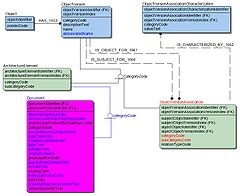|
Core Architecture Data Model
 Core Architecture Data Model (CADM) は、エンタープライズアーキテクチャにおいて、アーキテクチャの記述と構築に使われる情報の論理データモデルである[2]。 CADMは、本質的にはDoDAF内で定義された、共通のスキーマである。元々1997年に、アーキテクチャデータのための論理データモデルとして公表されたものである[3]。 全貌Core Architecture Data Model (CADM)は、標準化された構造でDoDAFアーキテクチャ情報を取り込むために設計された[4]。CADMはDoDAFのデータ要件を支援するため開発された。CADMは、アーキテクチャ記述内及び横断して統合を可能にするDoDAFアーキテクチャデータ要素のためのエンティティと関係性を定義する。このように、CADMは、ミッション領域、コンポーネント、及び連邦と連立パートナー間のアーキテクチャ情報の交換を支援することから、アーキテクチャのデータの相互運用性を促進する[5]。 CADMは、DoDAFに従ってアーキテクチャを統合することを可能になる重要な側面がある。これは、エンティティとオブジェクトの全てのアーキテクチャ記述のため、共通データ要素の定義、セマンティクス、及びデータ構造の利用を含む。CADMの基盤としての使用は、複数ビューを横断する共通オブジェクトと忠実に関係する。現在承認されているバージョンのCADMへの準拠を含めた、そのフレームワークの遵守は、アーキテクチャ開発のための共通アプローチと、関係するアーキテクチャへの基本的基盤の両方を提供する。CADMへの準拠は、共通のアーキテクチャデータ要素(またはタイプ)の使用を保証する[5]。 歴史The CADM was initially published in 1997 as a logical data model for architecture data. It was revised in 1998 to meet all the requirements of the C4ISR Architecture Framework Version 2.0.1 As a logical data model, the initial CADM provided a conceptual view of how architecture information is organized. It identified and defined entities, attributes, and relations. The CADM has evolved since 1998, so that it now has a physical view providing the data types, abbreviated physical names, and domain values that are needed for a database implementation. Because the CADM is also a physical data model, it constitutes a database design and can be used to automatically generate databases.[3] The CADM v1.01 was released with the DoD Architecture Framework v1.0 in August 2003. This DoDAF version restructured the C4ISR Framework v2.0 to offer guidance, product descriptions, and supplementary information in two volumes and a desk book. It broadened the applicability of architecture tenets and practices to all Mission Areas rather than just the C4ISR community. This document addressed usage, integrated architectures, DoD and Federal policies, value of architecture, architecture measures, DoD decision support processes, development techniques, analytical techniques, and the CADM v1.01, and moved towards a repository-based approach by placing emphasis on architecture data elements that comprise architecture products.[5] The CADM v1.5 was pre-released with the DoD Architecture Framework, v1.5 in April 2007. The DoDAF v1.5 was an evolution of the DoDAF v1.0 and reflects and leverages the experience that the DoD Components have gained in developing and using architecture descriptions. This transitional version provided additional guidance on how to reflect net-centric concepts within architecture descriptions, includes information on architecture data management and federating architectures through the Department, and incorporates the pre-release CADM v1.5, a simplified model of previous CADM versions that includes net-centric elements. Pre-release CADM v1.5 is also backward compatible with previous CADM versions. Data sets built in accordance with the vocabulary of CADM v1.02/1.03 can be expressed faithfully and completely using the constructs of CADM v1.5.[5] Note: For DoDAF V2.0, The DoDAF Meta-model (DM2) is working to replace the Core Architecture Data Model (CADM) which supported previous versions of the DoDAF. DM2 is a data construct that facilitates reader understanding of the use of data within an architecture document. CADM can continue to be used in support of architectures created in previous versions of DoDAF. CADM のトピックス構築ブロックThe major elements of a "core architecture data model" are described as follows:[3]
データモデリングと可視化The DoDAF incorporates data modeling (CADM) and visualization aspects (products and views) to support architecture analysis. The DoDAF’s data model, CADM, defines architecture data entities, the relationships between them, and the data entity attributes, essentially specifying the “grammar” for the architecture community. It contains a set of “nouns,” “verbs,” and “adjectives” that, together with the “grammar,” allow one to create “sentences” about architecture artifacts that are consistent with the DoDAF. The CADM is a necessary aspect of the architecture and provides the meaning behind the architectural visual representations (products). It enables the effective comparing and sharing of architecture data across the enterprise, contributing to the overall usefulness of architectures. The CADM describes the following data model levels in further detail:[5]
Data visualization is a way of graphically or textually representing architecture data to support decision-making analysis. The DoDAF provides products as a way of representing the underlying data in a user-friendly manner. In some cases, the existing DoDAF products are sufficient for representing the required information. Regardless of how one chooses to represent the architecture description, the underlying data (CADM) remains consistent, providing a common foundation to which analysis requirements are mapped.[5] CADM データモデルのダイアグラム表記 As illustrated in the figure, boxes represent entities for which architecture data are collected (representing tables when used for a relational database); they are depicted by open boxes with square corners (independent entities) or rounded corners (dependent entities). The entity name is outside and on top of the open box. The lines of text inside the box denote the attributes of that entity (representing columns in the entity table when used for a relational database). The horizontal line in each box separates the primary key attributes (used to find unique instances of the entity) from the non-key descriptive attributes.[1] The symbol with a circle and line underneath indicates subtyping, for which all the entities connected below are non-overlapping subsets of the entity connected at the top of the symbol. Relationships are represented by dotted (non-identifying) and solid (identifying) relationships in which the child entity (the one nearest the solid dot) has zero, one, or many instances associated to each instance of the parent entity (the other entity connected by the relationship line).[1] 基本のアーキテクチャ要素An architecture data repository responsive to the architecture products of the DoDAF contains information on basic architectural elements such as the following:[3] 
The depicted (conceptual) relationships shown in this diagram include the following (among many others):[3]
With these relationships, many types of architectural and related information can be represented such as networks, information flows, information requirements, interfaces, and so forth.[3] 関係モデルThe counterpart to CADM within NASA is the NASA Exploration Information Ontology Model (NeXIOM), which is designed to capture and expressively describe the engineering and programmatic data that drives exploration program decisions. NeXIOM is intended to be a repository that can be accessed by various simulation tools and models that need to exchange information and data.[4] 参照
|